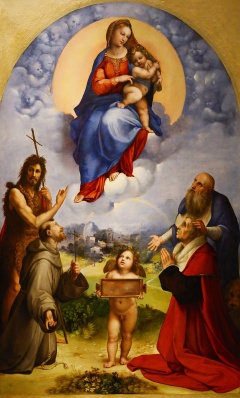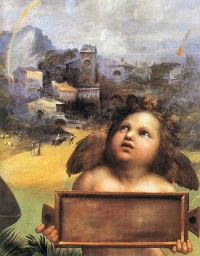(Unless otherwise stated, the copyright of the materials included belong to Jan Woreczko & Wadi.)
Madonna di Foligno (Rafael, obraz)
Z Wiki.Meteoritica.pl
„Bolid” na obrazie Rafaela? Może spadek meteorytu Crema?[1]
Madonna di Foligno – obraz namalowany w roku 1512 przez Rafaela Santi na zlecenie Sigismondo de' Conti. Przestawia Marię, Jana Chrzciciela, św. Franciszka, św. Hieronima oraz postać donatora. Interesujący jest namalowany w tle pejzaż na którym widać tęczę i „błyskawicę uderzającą w dom zleceniodawcy” (za Wikipedią). Lecz „błyskawica” ta bardziej przypomina bolid!? Podobne wizerunki bolidu znajdują się, np. na ilustracji z publikacji Haidingera (1866), na której zilustrowano spadek meteorytu Knyahinya.
Już wcześniej wielu historyków sztuki zwracało uwagę na ten tajemniczy detal na obrazie. Hasan Niyazi (portal 3PipeProblem) omawiając m.in. dwa detale tła – pustą tabliczkę trzymaną przez anioła (tabula ansata) oraz obiekt opisywany jako błyskawica – ten drugi identyfikuje jako meteor.
Fragment dotyczący meteoru (portal 3PipeProblem):
A meteorite?
Nineteenth century authors described a small background object depicted with a flame trailing behind it as an aerolite, or meteorite - theorising that the painting referred to an event affecting the patron. In an 1890 publication of the Astronomical Society of the Pacific, Edward S. Holden notes:
- Its purely astronomical interest consists in the portryal of the fall of the aerolite itself, which occupies the centre of the picture.[12][2]
Another explanation was offered by Professor H. A Newton[3], following up in 1891 on Holden’s notice the previous year. Newton cites a phenomenon reported in several contemporary sources:
- On the 4th of September, 1511, in the second hour of the night, there fell on the banks of the Adda, near Crema[1], some leagues southeast of Milan, a number of stones [...][4] We may well question nearly all the details of all the accounts, but that many stones fell and some were carried to Milan and other cities, can hardly be doubted. It is, so far as I know, the only detonating meteor falling in Italy during several years preceding 1512, of which account has been preserved. I believe that Raphael meant to represent this Crema aerolite in his painting of the Foligno Madonna.[13][3]
This object was also addressed by Schröter in 1987, emphasising that early sources do not mention that Sigismondo personally endured any form of bombardment or a lightning strike.[14][5] Schröter further suggests that the object depicted was a comet, symbolic of plague or an impending disaster. This is refuted by Meyer zur Capellen, arguing that the bright palette of the work does not match the types of works commonly associated with plague.[15] (…)
Czy Rafael namalował opisany w literaturze (Giovanni 1499-1519) „spadek meteorytów” obserwowany 4 września 1511 roku nad brzegiem rzeki Adda, niedaleko Cremy[1], kilka mil na południowy wschód od Mediolanu? (Bonaventure 1685; Bigot 1812; Chladni 1819). W bazie Meteoritical Bulletin Database nie ma informacji o spadku meteorytów w tym czasie!
Zapewne nie dowiemy się co tak naprawdę namalował Rafael – błyskawicę, meteor, spadek meteorytu, kometę – czym się inspirował i co chciał przekazać w swoim dziele? Ale niewątpliwie badacze historii sztuki będą mieli zajęcie jeszcze przez długi czas.
Źródła
Giovanni (1499-1519) za Newton (1891) (cytuje go również Chladni (1819) w trochę innym brzmieniu):
Ma prima che avanti col calamo scorra, dirò siccome il giorno quattro di settembre a ore due di notte, e anche alle sette apparve in aere in Milano un tale splendore di corrente fuoco, che parea refarsi il giorno; e da alcuni entro vi fu veduta una similitudine d'una grossa testa; il che diede alla città gran mara viglia e spavento; e il simile ancora accadette la notte seguente alle nove ore; poi dopo pochi giorni ultra il fiume Adda cascarono dal cielo molte prede (pietre) le quali raccolte furono nel Cremasco[1] de libbre undici, e de libbre octo di colore simile a pietra arsa.
Bibliografia
- Bigot de Morogues Pierre-Marie Sébastien, (1812), Mémoire historique et physique sur les chutes des pierres tombées sur la surface de la Terre à diverses époques, Orléans 1812, ss. 360, (s. 66).[6] Plik PDF; plik hPDF; plik DjVu.
- Bonaventure de Saint-Amable, (1685), Histoire de St Martial apôtre des Gaules et principalement de l'Aquitaine et du Limousin, (Annales du Limousin), vol. III, 1685, (s. 746). Plik GoogleBooks.
- Chladni Ernst F.F., (1819), Ueber Feuer-Meteore, und über die mit denselben herabgefallenen Massen (O ognistych meteorach i o masach spadających z nimi) (Nebst zehn Steindrucktafeln und deren Erklärung von Carl von Schreibers), Wien 1819, ss. 434, (s. 209-211).[7][8] Plik PDF[9]; plik GoogleBooks; plik doi.
- Giovanni Andrea da Prato, (1499-1519), Istoria di Milano composta da Giovanni Andrea da Prato contemporaneo a ciò che scrive, e serve di continuazione a Bernardino Corio dall' an. 1499 al 1519, Manuscritta nell' Ambrosiana di Milano („Si vegga Carlo Amoretti negli Opuscoli di Milano sulle scienze e sulle arti, par. 4, pag. 261, dove ne è riportato un brano”).[10]
- Holden Edward S., (1890), Contributions of Raphael and of Albrecht Dürer to Astronomy, Publications of the Astronomical Society of the Pacific, 2(6), 1890, s. 19-20. Plik PDF.
- Lubieniecki Stanisław, (1668), Stanislai de Lubienietz Lubieniecii Rolitsii Theatrum cometicum, duabus partibus constans… Cz. 1-3, Amstelodami, typis Danielis Baccamude, apud Franciscum Cuperum, Bibliopolam. Anno 1668, (s. 320, tom 2). Antologia 415 komet do roku 1655. Źródło: CBN Polona (wydanie z 1668 roku): Theatrum cometicum (całość). Pliki GoogleBooks (wydanie z 1681 roku): Theatrum cometicum tom 1 ● Theatrum cometicum tom 2.
- Newton Hubert Anson, (1891), The Fireball in Raphael's Madonna di Foligno, Publications of the Astronomical Society of the Pacific, 3(15), 1891, s. 91-95. Plik PDF.
- +Schröter Elisabeth, (1987), Raffaels Madonna di Foligno. Ein Pestbild?, Zeitschrift für Kunstgeschichte, 50(1), 1987, s. 46-87. Plik PDF.
Przypisy
Zobacz również
- meteoryt Knyahinya (ilustracja)
- Św. Hieronim na pustyni (Dürer, obraz)
- Lot z córkami (van Leyden, obraz)
- Obraz Matki Boskiej Częstochowskiej (wota)
Linki zewnętrzne
- Wikipedia – Madonna di Foligno ● Rafael Santi
- Portal 3PipeProblem – Three Pipe Problem: Raphael's Altar of Heaven - the Madonna di Foligno
- woreczko.pl – Wydarzenia 2012 • Events 2012

